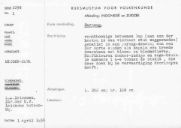Worn Away but Valuable
Since 2009, I have been doing research on batik, a resist-dyeing technique with wax in order to paint cloths. For my research on the Leidsche Katoenmaatschappij (Leiden cotton producer), I searched for objects with a story. I found this collection of six cloths, RV-2298-1 to RV-2298-1e, in the digital database of the Nationaal Museum van Wereldculturen. These batik cloths are located in the collection of Museum Volkenkunde in Leiden and show each stage of the manufacturing process.
This close-up shows us a fragment of the forth cloth. It is an example of how worn-out these cloths are: they are fragile, crumbly and dirty. The patterns do not look very spectacular either. There are even better and more recent examples available to show the batik process.
Then why make a story about these cloths specifically? First of all, this has to do with the person who donated these cloths. On the old inventory cards it says “L. A. Driessen, Dir. der N. V. Leidsche Katoenmij”. L. A. Driessen stands for Louis André Driessen (1890-1954), who was the director of the Leidsche Katoenmaatschappij, but above all a colorist.


